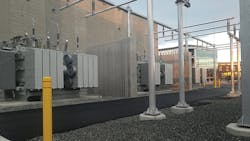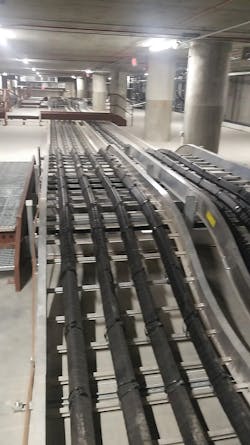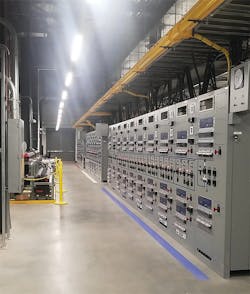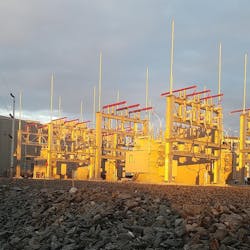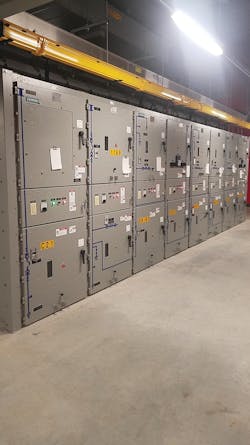Super Substation Design and Build
In 1919, the South Street substation opened as a state-of-the-art piece of critical infrastructure to help keep the lights on in the largest city in the U.S.’s smallest state, Providence, Rhode Island. Three 115-kV transmission lines delivered electricity to the substation, which then stepped down the voltage and sent it out to the state’s capital to nearby smaller substations. The typical substation built at that time had six circuits that sent out power; the South Street substation had 48 circuits.
For 100 years, such institutions as Brown University, Women & Infants Hospital, Rhode Island Hospital, Roger Williams Medical Center, the Veterans Administration Hospital and surrounding areas relied on the substation to provide energy that powered the state’s largest, most important economy. Together with the Franklin Square substation, the South Street substation provided electrical service to 150 MW of load in downtown Providence, including the downtown network, 10 distribution substations and hospitals. Owned and operated by National Grid plc, the substation performed admirably. For decades, it never experienced an outage, and it served as a vital cog in the city’s economic engine.
Fast forward to 2016, and the city of Providence’s aggressive plans for growth and economic development could no longer be sustained by the 100-year-old electrical substation. National Grid was faced with the challenge of ensuring safe, reliable energy coverage for the dense, busy urban city while effectively replacing the entire South Street substation. A five-year study completed by National Grid in 2014 identified a new substation as being critical for the continued safe and reliable delivery of electricity to the utility’s customers and much of the city.
Planning for Growth
The Davol Square section of the Providence Riverfront, located in the vicinity of Eddy Street, is undergoing a major redevelopment, taking advantage of parcels that became available after the relocation of Interstate 95. A partnership among the city of Providence, local universities and developers is proposing to build laboratories, classrooms, parking and dormitories on these parcels.
Another initiative is the Interstate 195 project, the Providence Innovation & Design District, launched in 2013 to redevelop land in the heart of the city to encourage growth, create jobs and enhance the city’s economic opportunity. When completed, the district will have a Science & Innovation Center, high-tech offices, residential condominiums and apartments, shopping, restaurants, public parks and more.
The legacy South Street substation was a 115/11.5-kV station consisting of the following:
- Outdoor yard housing three 115/11.5-kV power transformers (two rated 56 MVA and one rated 50 MVA), four 11.5/23-kV transformers (two rated 10 MVA and two rated 7.5 MVA) and an interconnecting bus
- 11.5-kV, three-section, segregated phase switchgear originally consisting of 76 oil-filled circuit breakers supplying 35 circuits and located inside a three-story brick building.
At 100 years old, equipment at the substation was no longer supported by the manufacturer. Spare parts had to be manufactured by a local machine shop using parts from retired equipment as a guideline. Modern 11.5-kV switchgear could not be retrofitted into the existing building as the current practice is to use non-segregated phase equipment. Additionally, the building that housed the switchgear needed structural repairs. As a result, National Grid determined a new substation was needed.
In 2016, the utility broke ground on the new substation, including a completely new building to house the infrastructure along with outdoor switching equipment. The new facility was located behind the South Street Landing parking garage and adjacent to the Providence River.
Managing Challenges
There were extensive challenges in designing and building the project. National Grid had to balance safety, power quality, reliability, operational flexibility, future expansion, aesthetics and cost. As a whole, the project consisted of the construction and installation of a two-story control building with 48 breakers and 27 feeder positions, which were made up of 49 sets of cables.
The utility was building the new substation while immediate abutters also were constructing projects, a parking garage and the remodel of a historical building. Construction of the control building was challenging because of the number of contractors at the site an any given times. At the peak of construction, more than 100 people were working on-site at any time.
Working in such a confined area in the bustling downtown Providence area became extremely challenging because of the construction traffic from the three concurrent projects. The limited construction space also made it difficult to handle and store all the contaminated dirt that was excavated while installing numerous T&D duct banks.
Aside from coordination challenges with other construction, the work itself was highly complex. Existing underground facilities, such as water, sewer, communications, electric duct banks and other abandoned foundations, became difficult to overcome when designing and constructing the T&D duct banks. To solve the issue, National Grid raised the site in certain areas to install the distribution duct bank. For the transmission duct bank, workers had to install the bank approximately 15 ft to 20 ft (4.6 m to 6.1 m) deep and use pipe jacking means to install a centrifugally cast fiberglass reinforced polymer mortar (CCFRPM) pipe, and then install the needed conduit.
Routing of the distribution cables through the basement of the control building also was challenging. Cable trays were installed as raceways to route the cables to the designated breakers. National Grid’s new transmission underground cables had to be installed through the property of one of the other projects.
Design Focus
When designing the substation, National Grid sought to install state-of-the-art technology. One example is the 63-kA rated arc-resistant switchgear manufactured by Siemens to replace the dated breakers and protection scheme in the old substation. In addition, fiber-optic cables were installed as a communication means between the new South Street substation and connecting substations.
The project also was designed to uphold the highest safety standards for National Grid employees, residents in the local area and customers. Safety design features of the substation include enhancements to address existing indoor operating concerns, arc-flash-resistant switchgear, fault current mitigation and a Kirk Key interlock system for switching operation. The metal enclosed disconnect switches were designed with special barriers to isolate workers from energized parts.
Because of the limited space available to build a new substation, while keeping the existing substation operational, TRC Companies Inc. was contracted to design a two-story control building to house some of the major equipment, including the 63-kA switchgear, indoor reactors and switches. The building was designed to safely support the major equipment during normal operations and withstand system faults. This included structural reinforcements in the walls, roof and floors as well as the equipment and cable constraints. Although the building was robust and seismic, the concrete floor deflected enough during the installation of the switchgear that it became difficult to assemble the gear.
Not only does the two-story control building hide a portion of the substation equipment, it also was designed to blend in with the city’s overall vibe. Kite Architects designed the exterior of the control building that houses the substation equipment. Stamped-concrete panels include detailing of interference waves in homage to the physics of electricity. Vents, louvers and observation windows also were artfully placed to showcase the critical infrastructure contained within the building.
The basement of the control building houses more than 25 11.5-kV distribution circuits, which required a complicated layout. TRC adopted the Bentley substation tool to create 3-D models and walk-throughs to present, discuss and fine-tune South Street’s complicated design.
“Bentley substation software was a critical design tool enabling us to engineer, coordinate, and share data models and 3D dynamic visualizations with members of the multi-disciplined design team and most importantly, National Grid, in the design and construction of this facility,” TRC Principal Engineer William J. Bell, PE said. This better enabled consulting architects and engineers to develop an integrated design that worked throughout the overall station with minimal changes before the shovels ever hit the ground.
Super Substation
The project was initially estimated to cost US$95 million to build. By finding some efficiencies, including cost savings in equipment, limiting the scope of the project and limiting excavation of the site, the final cost of the station was $10 million less, at $85 million. This new super substation is enabling National Grid to contribute to the revitalization of downtown Providence and transform the land near I-195.
“The South Street Substation allows us to supply existing and new electrical loads as a result of all of the new construction that is taking place in the Providence downtown area” Antunes said.
The new substation also is significantly easier to operate and maintain. “Going from a one- and two-bus system to a breaker-and-half allows us to cut down on maintenance hours,” said Mike Morin, lead supervisor at National Grid for substation maintenance in Rhode Island. “In the old South Street substation, it would take six switch persons nine hours to transfer the bus to do maintenance on one breaker. All disconnect switches were hand operated and checked open on three floors.
“Now breakers are SCADA operated and are remotely racked out, cutting switching time for maintenance from hours down to minutes and allowing us a higher standard of safety when performing the switching task,” Morin continued. “Having modern equipment streamlines our maintenance, since having available replacement parts on hand and being able to swap breakers from one cube to the next enhances our reliability.”
The biggest challenge for operation personnel was the complexity of phasing the old station and new station, as a result of the indoor radius bus turns and three sections as well as the old station being 300 ft (91 m) away. “This is a great project and one of the biggest substations on the East Coast,” Antunes said.
The new substation was finally completed, energized and brought on-line in the spring of 2019. Demolition of the old substation was the last task to be done. It completed in the fall, with the last brick of the old station being hauled away in November 2019.
From the complexity of the substation and the congested work zone to the challenges of demolishing the old substation and working with the many partners involved with the development of the downtown area, the vast scope of work made the South Street substation a challenging yet rewarding project. With this new super substation in place, Providence will be powered well into the future.
For more information:
Kirk Key Interlock Co. | www.kirkkey.com
Kite Architects | https://kitearchitects.com
Siemens | https://new.siemens.com/us/en.html
About the Author
Nelson Antunes
Nelson Antunes is a lead project manager at National Grid who is responsible for managing distribution, transmission and substation projects throughout their full lifecycle. He joined National Grid in 2003 as a distribution engineer responsible for designing various complex distribution services. Antunes is an electrical engineer with a masters in power systems management with a project management certification from the Project Management Institute and is a registered Certified Utility Safety Professional (CUSP).
Kalpana Dulipsingh
Kalpana Dulipsingh is a manager with the Substation Engineering and Design Group at National Grid, having joined in 2009 after working as an electrical engineer for more than 15 years in other organizations. She has a masters in electrical power engineering from Rensselaer Polytechnic Institute and is a certified professional engineer and project manager.
Michael Morin
Michael Morin is a lead operations supervisor of Rhode Island Substations at National Grid, responsible for the safe, efficient, and reliable operation of more than 111 transmission and distribution stations in Rhode Island. Morin leads a team of 49 substation supervisors and maintenance personnel. He has been a member of the National Grid team for 33 years. Morin received his undergraduate degree from Holy Name University.
